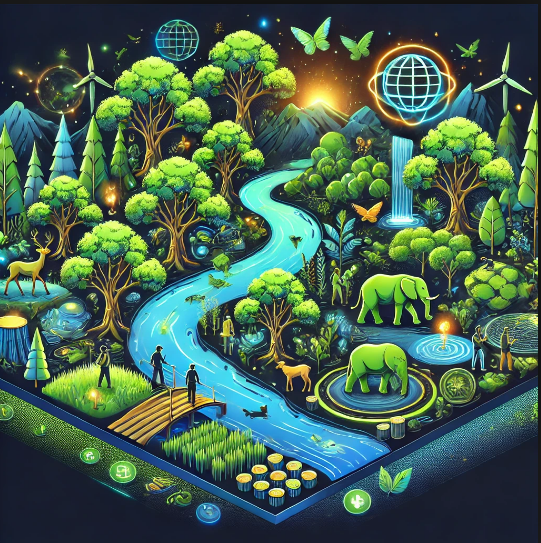The Vision Plan 2030 of the Uttar Pradesh Government reflects a comprehensive commitment to sustainable development, with a particular focus on the preservation and enhancement of the terrestrial ecosystem. This ambitious roadmap aligns with the United Nations’ Sustainable Development Goals (SDGs), especially Goal 15, which emphasizes life on land and calls for sustainable management of forests, combating desertification, halting and reversing land degradation, and preventing biodiversity loss.
This document explores the Vision Plan 2030 in detail, covering its goals, strategies, and initiatives for the conservation and management of the terrestrial ecosystem in Uttar Pradesh.
Key Objectives of Vision Plan 2030
The Vision Plan 2030 outlines specific objectives aimed at protecting and enhancing the terrestrial ecosystem of Uttar Pradesh. These objectives include:
- Forest and Tree Cover Expansion
- Increase forest and tree cover to at least 20% of the state’s geographical area.
- Promote afforestation and reforestation programs on degraded lands and wastelands.
- Biodiversity Conservation
- Preserve and protect native flora and fauna.
- Develop and maintain biodiversity parks, wildlife sanctuaries, and ecological corridors.
- Combat the spread of invasive species that threaten biodiversity.
- Sustainable Land Management
- Prevent soil degradation and desertification through sustainable agricultural practices.
- Promote land reclamation projects in areas affected by soil erosion or salinity.
- Water Resource Management
- Protect wetlands, rivers, and other freshwater ecosystems that support terrestrial biodiversity.
- Promote catchment area treatment and rainwater harvesting to ensure groundwater recharge.
- Climate Change Mitigation and Adaptation
- Enhance the resilience of terrestrial ecosystems to the impacts of climate change.
- Promote agroforestry and sustainable farming practices to reduce greenhouse gas emissions.
- Community Participation
- Empower local communities, particularly tribal and rural populations, to participate in ecosystem conservation.
- Promote awareness and education about the importance of biodiversity and sustainable living.
Major Strategies and Initiatives
To achieve these objectives, the Uttar Pradesh Government has proposed a range of strategies and initiatives as part of Vision Plan 2030. These include policy frameworks, infrastructure development, and community-driven programs.
1. Afforestation and Reforestation Initiatives
The government has launched massive afforestation drives aimed at increasing green cover in the state. Key initiatives include:
- Van Mahotsav (Forest Festival): Annual tree plantation campaigns involving local communities, schools, and NGOs.
- Urban Green Spaces: Development of parks and green belts in urban areas to reduce pollution and enhance biodiversity.
- Agroforestry Programs: Encouraging farmers to integrate trees with agricultural crops to enhance productivity and ecosystem services.
2. Conservation of Biodiversity
Efforts to conserve biodiversity in Uttar Pradesh include:
- Wildlife Sanctuaries and National Parks: Strengthening the management of protected areas such as Dudhwa National Park, Katarniaghat Wildlife Sanctuary, and others.
- Biodiversity Parks: Establishing biodiversity parks in key locations to preserve native species and educate the public.
- In-Situ and Ex-Situ Conservation: Promoting both in-situ conservation (within natural habitats) and ex-situ conservation (botanical gardens, seed banks, etc.).
3. Soil and Land Reclamation
To address land degradation, the government has adopted sustainable land management practices, such as:
- Watershed Management Projects: Implementing soil and water conservation measures in watershed areas.
- Soil Health Cards: Providing farmers with soil health assessments and recommendations to optimize agricultural productivity while maintaining soil quality.
4. Wetland Conservation
Wetlands in Uttar Pradesh, such as Sur Sarovar and Nawabganj Bird Sanctuary, are critical for biodiversity. The government aims to:
- Identify and map all wetlands in the state.
- Implement conservation plans to protect these ecosystems from pollution, encroachment, and overexploitation.
5. Combating Desertification
The state faces challenges related to land degradation and desertification, particularly in western Uttar Pradesh. Key measures include:
- Promoting drought-resistant crops in arid regions.
- Using scientific techniques like contour bunding and check dams to prevent soil erosion.
6. Renewable Energy Integration
To reduce the ecological footprint, the state is integrating renewable energy projects such as solar and wind power with ecosystem conservation efforts. This includes:
- Solar pumps for irrigation to reduce dependency on fossil fuels.
- Installation of renewable energy systems in protected areas to minimize environmental disturbance.
7. Strengthening Forest Governance
The government is modernizing forest management by:
- Using satellite technology for real-time monitoring of forest cover and wildlife habitats.
- Enhancing the capacity of forest departments through training and technology adoption.
Community Participation in Ecosystem Management
Community involvement is a cornerstone of the Vision Plan 2030. Empowering local communities ensures the sustainable management of resources and long-term conservation success.
Joint Forest Management (JFM) Committees
- The government promotes the formation of JFM committees to involve local communities in forest protection and management.
- These committees ensure equitable sharing of forest benefits and encourage sustainable harvesting practices.
Eco-Tourism Development
- Uttar Pradesh is developing eco-tourism projects that generate income for local communities while promoting conservation.
- Visitors are encouraged to experience the state’s rich biodiversity through guided tours, birdwatching, and nature trails.
Awareness and Capacity Building
- Environmental education programs are conducted in schools and colleges to foster a conservation mindset among the youth.
- Training workshops for farmers, tribal communities, and other stakeholders focus on sustainable practices and biodiversity preservation.
Climate Change and Ecosystem Resilience
Climate change poses significant threats to terrestrial ecosystems in Uttar Pradesh. The Vision Plan 2030 incorporates strategies to mitigate these impacts:
- Agroforestry Practices: Promoting tree planting on farmlands to sequester carbon and reduce heat stress on crops.
- Green Corridors: Creating wildlife corridors to ensure the safe movement of animals and reduce human-wildlife conflict.
- Disaster Preparedness: Developing early warning systems and disaster response plans for areas prone to floods, droughts, and forest fires.
Monitoring and Evaluation
A robust monitoring and evaluation framework is crucial for assessing the progress of Vision Plan 2030. The government has outlined the following mechanisms:
- Periodic Audits: Regular audits of forest cover, biodiversity, and land use changes using satellite imagery and GIS tools.
- Performance Indicators: Setting measurable targets for afforestation, biodiversity conservation, and land restoration.
- Stakeholder Feedback: Engaging with local communities, environmentalists, and researchers to incorporate their insights into policy revisions.
Challenges and Road Ahead
While the Vision Plan 2030 is ambitious, several challenges need to be addressed to ensure its success:
- Urbanization Pressure: Rapid urbanization poses threats to natural habitats, requiring stricter enforcement of land-use regulations.
- Resource Constraints: Limited financial and human resources may hinder the implementation of large-scale conservation projects.
- Climate Variability: Unpredictable weather patterns may impact afforestation and biodiversity conservation efforts.
Despite these challenges, the Uttar Pradesh Government is committed to achieving its goals through innovative policies, stakeholder engagement, and adaptive management.
Conclusion
The Vision Plan 2030 of Uttar Pradesh Government represents a holistic approach to conserving and restoring the state’s terrestrial ecosystems. By focusing on afforestation, biodiversity conservation, sustainable land use, and community participation, the plan aims to balance ecological preservation with socio-economic development. With sustained efforts and collaboration among all stakeholders, Uttar Pradesh can serve as a model for terrestrial ecosystem management, ensuring a greener and more sustainable future for generations to come.




